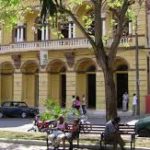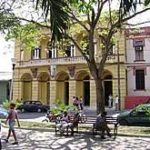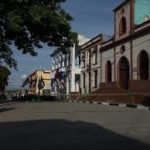

 PALMA SORIANO, CUBA, 16ª CIUDAD MÁS GRANDE DE LA ISLA.
PALMA SORIANO, CUBA, 16ª CIUDAD MÁS GRANDE DE LA ISLA.
Palma Soriano es una ciudad y municipio cubano de la provincia de Santiago de Cuba. Con una población de 76.179 en la ciudad propiamente dicha, es la segunda más grande de la provincia y la 16a más grande de Cuba.
Historia
La ciudad fue fundada en 1825, uniendo los ranchos (haciendas) que se levantaron en esta zona, y fue el lugar donde se trajo el cuerpo de José Martí (el líder del movimiento independentista cubano, asesinado en 1895, en la Batalla de Dos Ríos) antes de que fuera colocado en su lugar de descanso final en Santiago de Cuba.
Geografía
La ciudad de Palma Soriano está ubicada a orillas del alto río Cauto. El municipio se divide en las localidades de Aguacate, Arroyo Blanco, Candonga, Dos Palmas, Dos Ríos, El Maniel, Hatillo, Hicotea, La Candelaria, La Curia, Oriente, Ramón de Guaninao, Soledad, Yarayabo y otras localidades menores.
Hasta la reforma municipal nacional de 1976, incluía las localidades de Alto Cedro, Caney del Sitio, Guaninao, José Martí, Juan Barón, La Concepción, Las Cuchillas, Los Dorados, Norte, Palmarito de Cauto, San Leandro, San Ramón, Santa Filomena. y Sur.
Demografía
En 2004, el municipio de Palma Soriano tenía una población de 124.585. Con una superficie total de 846 km2 (327 millas cuadradas), tiene una densidad de población de 147,3 / km2 (382 / mi2).
Transporte
La ciudad está atravesada en el medio por la carretera estatal “Carretera Central” (CC), la carretera más larga de Cuba. Cuenta con dos salidas (una en la vecina aldea de Dos Ríos) de la autopista A1, en el tramo Palma-Santiago de Cuba.
La estación de tren de Palma Soriano es parte de la línea San Luis-Bayamo y es servida por trenes desde / hacia Santiago de Cuba, Guantánamo y Manzanillo.
Alusiones personales
Orestes Kindelán (n. 1964), jugador de béisbol; Jorge Molina Enríquez (n. 1966), actor y director de cine; Ana Fidelia Quirot (n. 1963), atleta de campo y pista; Mey Vidal (n. 1984), cantante de reggae latino.


 PALMA SORIANO, CUBA, 16th LARGEST CITY OF THE ISLAND.
PALMA SORIANO, CUBA, 16th LARGEST CITY OF THE ISLAND.
Palma Soriano is a Cuban city and municipality in the Santiago de Cuba Province. With a population of 76,179 in the city proper, it is the second-largest in the province and the 16th-largest in Cuba.
History
The city was founded in 1825, uniting ranches (haciendas) that stood in this area, and was the place where the body of José Martí (the leader of the Cuban independence movement, killed in 1895, in the Battle of Dos Ríos) was brought before it was laid in its final resting place in Santiago de Cuba.
Geography
The city of Palma Soriano is located on the banks of the upper Cauto River. The municipality is divided into the localities of Aguacate, Arroyo Blanco, Candonga, Dos Palmas, Dos Ríos, El Maniel, Hatillo, Hicotea, La Candelaria, La Curia, Oriente, Ramón de Guaninao, Soledad, Yarayabo and other minor localities.
Until the 1976 national municipal reform, it included the localities of Alto Cedro, Caney del Sitio, Guaninao, José Martí, Juan Barón, La Concepción, Las Cuchillas, Los Dorados, Norte, Palmarito de Cauto, San Leandro, San Ramón, Santa Filomena and Sur.
Demographics
In 2004, the municipality of Palma Soriano had a population of 124,585. With a total area of 846 km2 (327 sq mi), it has a population density of 147.3/km2 (382/sq mi).
Transport
The city is crossed in the middle by the state highway “Carretera Central” (CC), the longest highway in Cuba. It is served by two exits (one in the nearby hamlet of Dos Ríos) of the A1 motorway, on the Palma-Santiago de Cuba section.
Palma Soriano railway station is part of the San Luis-Bayamo line and is served by trains to/from Santiago de Cuba, Guantánamo, and Manzanillo.
Personalities
Orestes Kindelán (b. 1964), baseball player
Jorge Molina Enríquez (b. 1966), actor and film director
Ana Fidelia Quirot (b. 1963), field and track athlete
Mey Vidal (b. 1984), Latin Reggae sing
Agencies/ Wiki/ Various/ Internet Photos/ Arnoldo Varona/ www.TheCubanHistory.com
THE CUBAN HISTORY, HOLLYWOOD.



 PALMA SORIANO, CUBA: 16ª Ciudad más Grande de la Isla. PHOTOS.
PALMA SORIANO, CUBA: 16ª Ciudad más Grande de la Isla. PHOTOS.




